change wheel JEEP CHEROKEE 2021 Owner handbook (in English)
[x] Cancel search | Manufacturer: JEEP, Model Year: 2021, Model line: CHEROKEE, Model: JEEP CHEROKEE 2021Pages: 332, PDF Size: 8.87 MB
Page 3 of 332
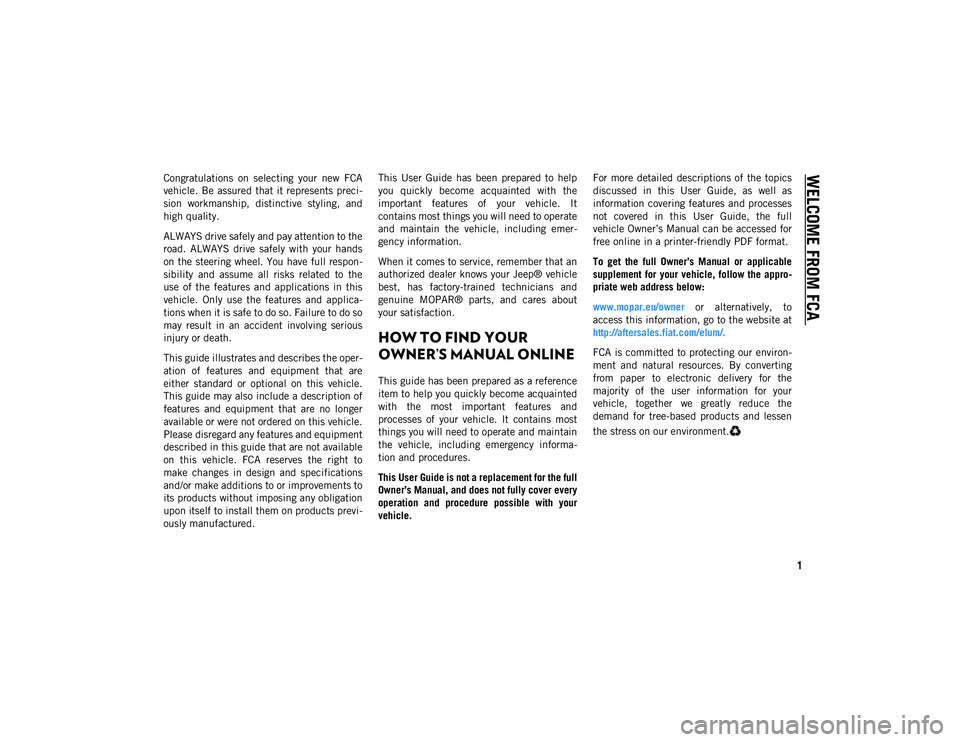
1
WELCOME FROM FCA
Congratulations on selecting your new FCA
vehicle. Be assured that it represents preci-
sion workmanship, distinctive styling, and
high quality.
ALWAYS drive safely and pay attention to the
road. ALWAYS drive safely with your hands
on the steering wheel. You have full respon -
sibility and assume all risks related to the
use of the features and applications in this
vehicle. Only use the features and applica -
tions when it is safe to do so. Failure to do so
may result in an accident involving serious
injury or death.
This guide illustrates and describes the oper -
ation of features and equipment that are
either standard or optional on this vehicle.
This guide may also include a description of
features and equipment that are no longer
available or were not ordered on this vehicle.
Please disregard any features and equipment
described in this guide that are not available
on this vehicle. FCA reserves the right to
make changes in design and specifications
and/or make additions to or improvements to
its products without imposing any obligation
upon itself to install them on products previ -
ously manufactured. This User Guide has been prepared to help
you quickly become acquainted with the
important features of your vehicle. It
contains most things you will need to operate
and maintain the vehicle, including emer
-
gency information.
When it comes to service, remember that an
authorized dealer knows your Jeep® vehicle
best, has factory-trained technicians and
genuine MOPAR® parts, and cares about
your satisfaction.
HOW TO FIND YOUR
OWNER’S MANUAL ONLINE
This guide has been prepared as a reference
item to help you quickly become acquainted
with the most important features and
processes of your vehicle. It contains most
things you will need to operate and maintain
the vehicle, including emergency informa -
tion and procedures.
This User Guide is not a replacement for the full
Owner’s Manual, and does not fully cover every
operation and procedure possible with your
vehicle. For more detailed descriptions of the topics
discussed in this User Guide, as well as
information covering features and processes
not covered in this User Guide, the full
vehicle Owner’s Manual can be accessed for
free online in a printer-friendly PDF format.
To get the full Owner’s Manual or applicable
supplement for your vehicle, follow the appro
-
priate web address below:
www.mopar.eu/owner or alternatively, to
access this information, go to the website at
http://aftersales.fiat.com/elum/.
FCA is committed to protecting our environ -
ment and natural resources. By converting
from paper to electronic delivery for the
majority of the user information for your
vehicle, together we greatly reduce the
demand for tree-based products and lessen
the stress on our environment.
2020_JEEP_CHEROKEE_UG_RHD_UK.book Page 1
Page 17 of 332
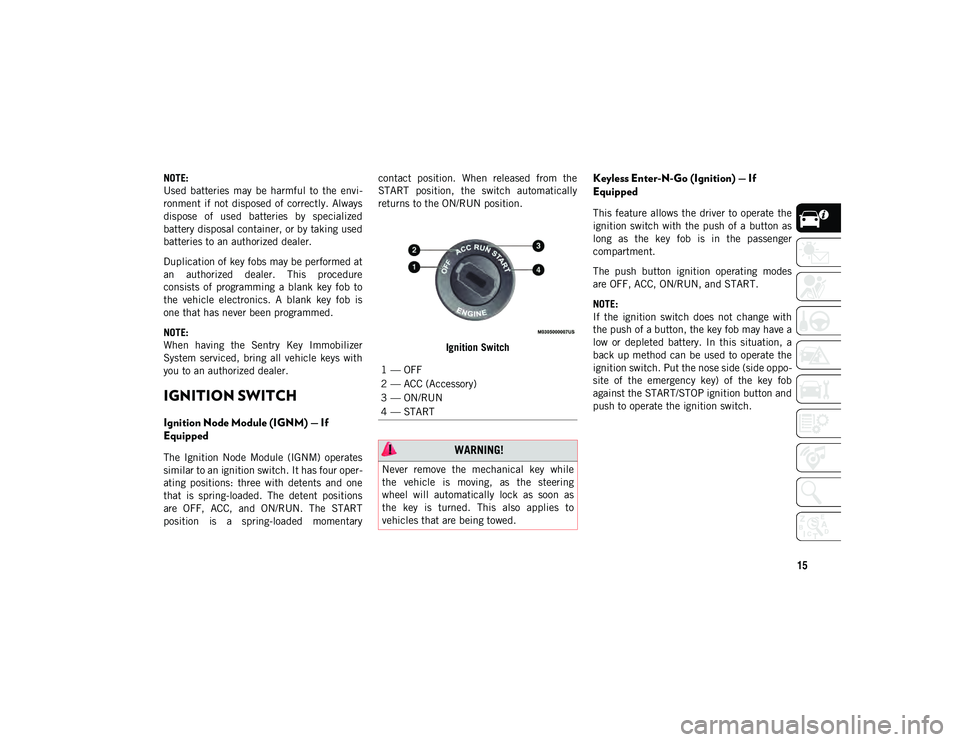
15
NOTE:
Used batteries may be harmful to the envi-
ronment if not disposed of correctly. Always
dispose of used batteries by specialized
battery disposal container, or by taking used
batteries to an authorized dealer.
Duplication of key fobs may be performed at
an authorized dealer. This procedure
consists of programming a blank key fob to
the vehicle electronics. A blank key fob is
one that has never been programmed.
NOTE:
When having the Sentry Key Immobilizer
System serviced, bring all vehicle keys with
you to an authorized dealer.
IGNITION SWITCH
Ignition Node Module (IGNM) — If
Equipped
The Ignition Node Module (IGNM) operates
similar to an ignition switch. It has four oper -
ating positions: three with detents and one
that is spring-loaded. The detent positions
are OFF, ACC, and ON/RUN. The START
position is a spring-loaded momentary contact position. When released from the
START position, the switch automatically
returns to the ON/RUN position.
Ignition Switch
Keyless Enter-N-Go (Ignition) — If
Equipped
This feature allows the driver to operate the
ignition switch with the push of a button as
long as the key fob is in the passenger
compartment.
The push button ignition operating modes
are OFF, ACC, ON/RUN, and START.
NOTE:
If the ignition switch does not change with
the push of a button, the key fob may have a
low or depleted battery. In this situation, a
back up method can be used to operate the
ignition switch. Put the nose side (side oppo -
site of the emergency key) of the key fob
against the START/STOP ignition button and
push to operate the ignition switch.
1 — OFF
2 — ACC (Accessory)
3 — ON/RUN
4 — START
WARNING!
Never remove the mechanical key while
the vehicle is moving, as the steering
wheel will automatically lock as soon as
the key is turned. This also applies to
vehicles that are being towed.
2020_JEEP_CHEROKEE_UG_RHD_UK.book Page 15
Page 45 of 332
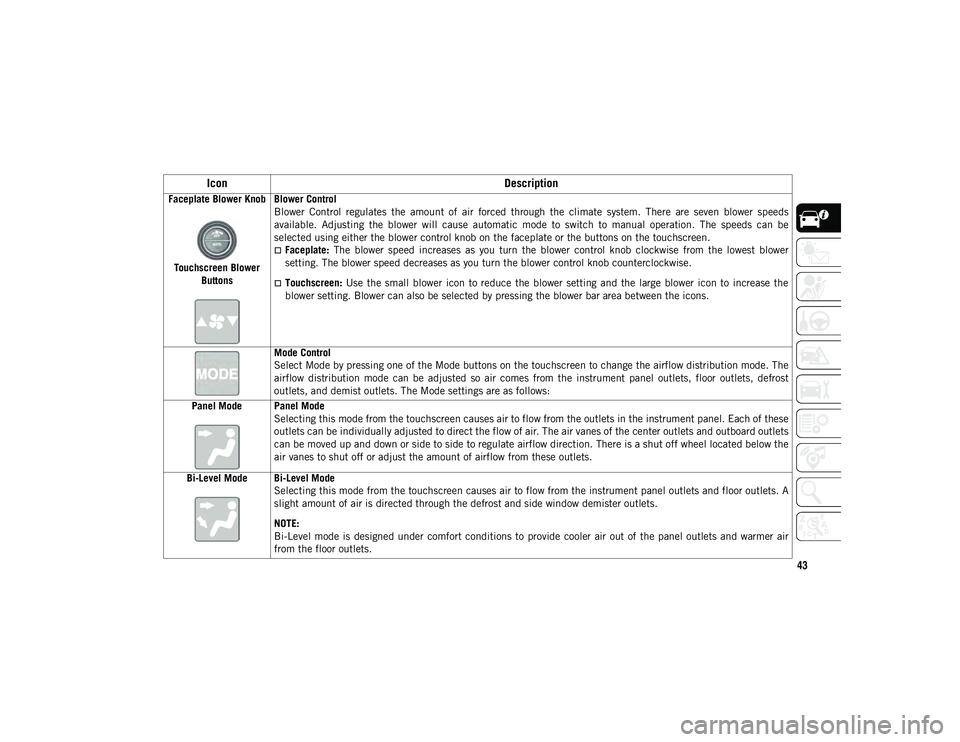
43
Faceplate Blower KnobTouchscreen Blower Buttons Blower Control
Blower Control regulates the amount of air forced through the climate system. There are seven blower speeds
available. Adjusting the blower will cause automatic mode to switch to manual operation. The speeds can be
selected using either the blower control knob on the faceplate or the buttons on the touchscreen.
Faceplate:
The blower speed increases as you turn the blower control knob clockwise from the lowest blower
setting. The blower speed decreases as you turn the blower control knob counterclockwise.
Touchscreen: Use the small blower icon to reduce the blower setting and the large blower icon to increase the
blower setting. Blower can also be selected by pressing the blower bar area between the icons.
Mode Control
Select Mode by pressing one of the Mode buttons on the touchscreen to change the airflow distribution mode. The
airflow distribution mode can be adjusted so air comes from the instrument panel outlets, floor outlets, defrost
outlets, and demist outlets. The Mode settings are as follows:
Panel Mode Panel Mode Selecting this mode from the touchscreen causes air to flow from the outlets in the instrument panel. Each of these
outlets can be individually adjusted to direct the flow of air. The air vanes of the center outlets and outboard outlets
can be moved up and down or side to side to regulate airflow direction. There is a shut off wheel located below the
air vanes to shut off or adjust the amount of airflow from these outlets.
Bi-Level Mode Bi-Level Mode Selecting this mode from the touchscreen causes air to flow from the instrument panel outlets and floor outlets. A
slight amount of air is directed through the defrost and side window demister outlets.
NOTE:
Bi-Level mode is designed under comfort conditions to provide cooler air out of the panel outlets and warmer air
from the floor outlets.
Icon Description
2020_JEEP_CHEROKEE_UG_RHD_UK.book Page 43
Page 62 of 332
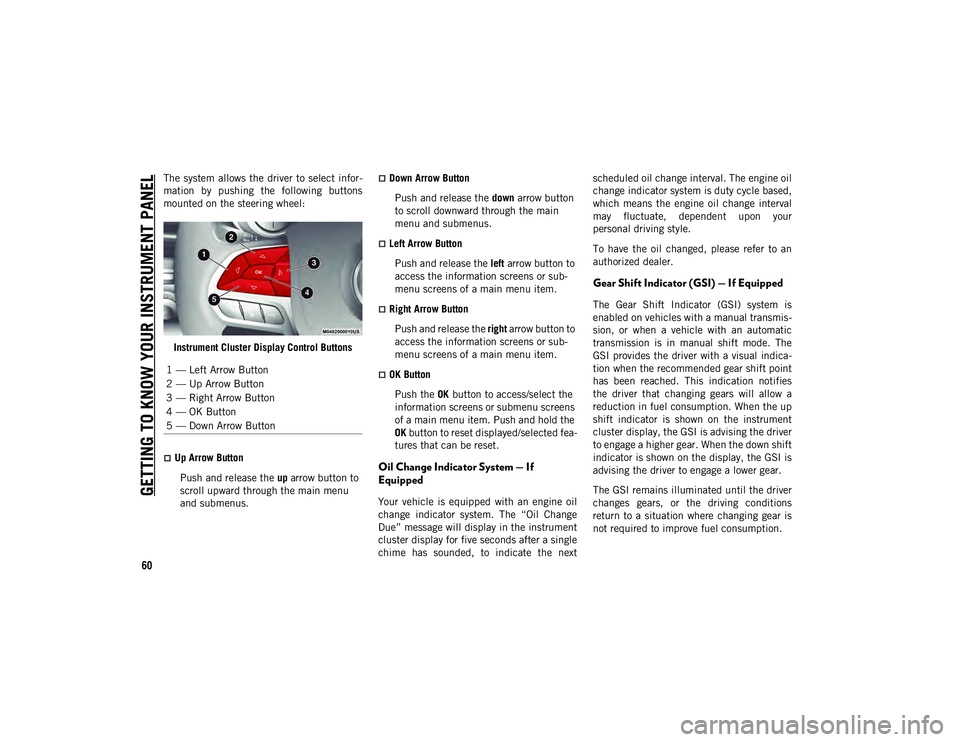
GETTING TO KNOW YOUR INSTRUMENT PANEL
60
The system allows the driver to select infor-
mation by pushing the following buttons
mounted on the steering wheel:
Instrument Cluster Display Control Buttons
Up Arrow ButtonPush and release the up arrow button to
scroll upward through the main menu
and submenus.
Down Arrow Button
Push and release the down arrow button
to scroll downward through the main
menu and submenus.
Left Arrow Button
Push and release the left arrow button to
access the information screens or sub -
menu screens of a main menu item.
Right Arrow Button
Push and release the right arrow button to
access the information screens or sub -
menu screens of a main menu item.
OK Button
Push the OK button to access/select the
information screens or submenu screens
of a main menu item. Push and hold the
OK button to reset displayed/selected fea -
tures that can be reset.
Oil Change Indicator System — If
Equipped
Your vehicle is equipped with an engine oil
change indicator system. The “Oil Change
Due” message will display in the instrument
cluster display for five seconds after a single
chime has sounded, to indicate the next scheduled oil change interval. The engine oil
change indicator system is duty cycle based,
which means the engine oil change interval
may fluctuate, dependent upon your
personal driving style.
To have the oil changed, please refer to an
authorized dealer.
Gear Shift Indicator (GSI) — If Equipped
The Gear Shift Indicator (GSI) system is
enabled on vehicles with a manual transmis
-
sion, or when a vehicle with an automatic
transmission is in manual shift mode. The
GSI provides the driver with a visual indica -
tion when the recommended gear shift point
has been reached. This indication notifies
the driver that changing gears will allow a
reduction in fuel consumption. When the up
shift indicator is shown on the instrument
cluster display, the GSI is advising the driver
to engage a higher gear. When the down shift
indicator is shown on the display, the GSI is
advising the driver to engage a lower gear.
The GSI remains illuminated until the driver
changes gears, or the driving conditions
return to a situation where changing gear is
not required to improve fuel consumption.
1 — Left Arrow Button
2 — Up Arrow Button
3 — Right Arrow Button
4 — OK Button
5 — Down Arrow Button
2020_JEEP_CHEROKEE_UG_RHD_UK.book Page 60
Page 80 of 332
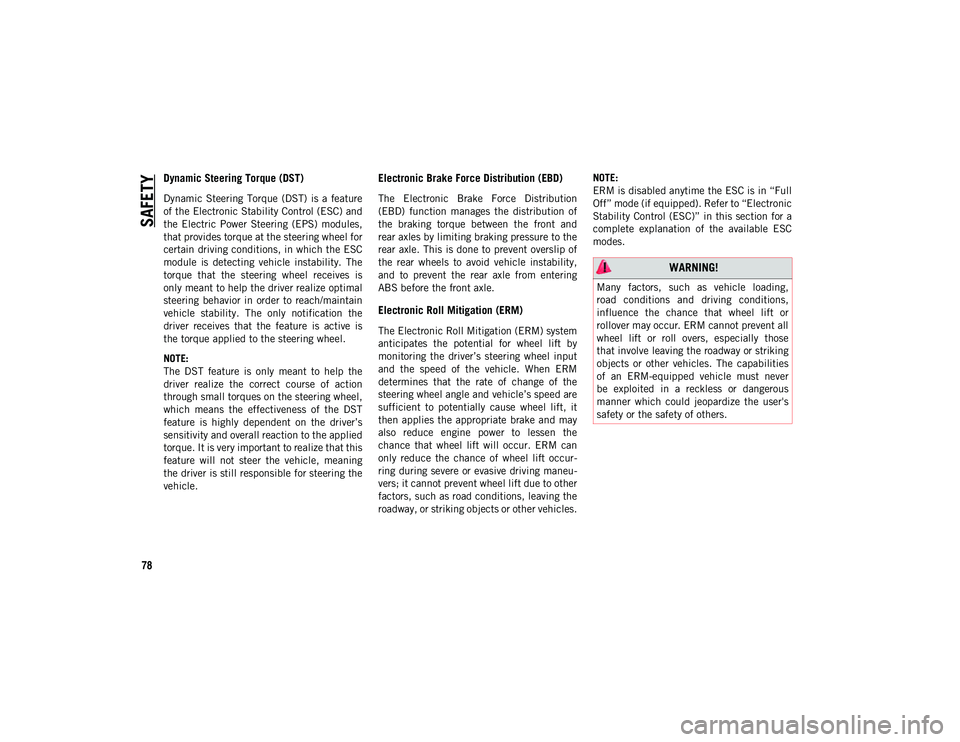
SAFETY
78
Dynamic Steering Torque (DST)
Dynamic Steering Torque (DST) is a feature
of the Electronic Stability Control (ESC) and
the Electric Power Steering (EPS) modules,
that provides torque at the steering wheel for
certain driving conditions, in which the ESC
module is detecting vehicle instability. The
torque that the steering wheel receives is
only meant to help the driver realize optimal
steering behavior in order to reach/maintain
vehicle stability. The only notification the
driver receives that the feature is active is
the torque applied to the steering wheel.
NOTE:
The DST feature is only meant to help the
driver realize the correct course of action
through small torques on the steering wheel,
which means the effectiveness of the DST
feature is highly dependent on the driver’s
sensitivity and overall reaction to the applied
torque. It is very important to realize that this
feature will not steer the vehicle, meaning
the driver is still responsible for steering the
vehicle.
Electronic Brake Force Distribution (EBD)
The Electronic Brake Force Distribution
(EBD) function manages the distribution of
the braking torque between the front and
rear axles by limiting braking pressure to the
rear axle. This is done to prevent overslip of
the rear wheels to avoid vehicle instability,
and to prevent the rear axle from entering
ABS before the front axle.
Electronic Roll Mitigation (ERM)
The Electronic Roll Mitigation (ERM) system
anticipates the potential for wheel lift by
monitoring the driver’s steering wheel input
and the speed of the vehicle. When ERM
determines that the rate of change of the
steering wheel angle and vehicle’s speed are
sufficient to potentially cause wheel lift, it
then applies the appropriate brake and may
also reduce engine power to lessen the
chance that wheel lift will occur. ERM can
only reduce the chance of wheel lift occur-
ring during severe or evasive driving maneu -
vers; it cannot prevent wheel lift due to other
factors, such as road conditions, leaving the
roadway, or striking objects or other vehicles. NOTE:
ERM is disabled anytime the ESC is in “Full
Off” mode (if equipped). Refer to “Electronic
Stability Control (ESC)” in this section for a
complete explanation of the available ESC
modes.
WARNING!
Many factors, such as vehicle loading,
road conditions and driving conditions,
influence the chance that wheel lift or
rollover may occur. ERM cannot prevent all
wheel lift or roll overs, especially those
that involve leaving the roadway or striking
objects or other vehicles. The capabilities
of an ERM-equipped vehicle must never
be exploited in a reckless or dangerous
manner which could jeopardize the user's
safety or the safety of others.
2020_JEEP_CHEROKEE_UG_RHD_UK.book Page 78
Page 81 of 332
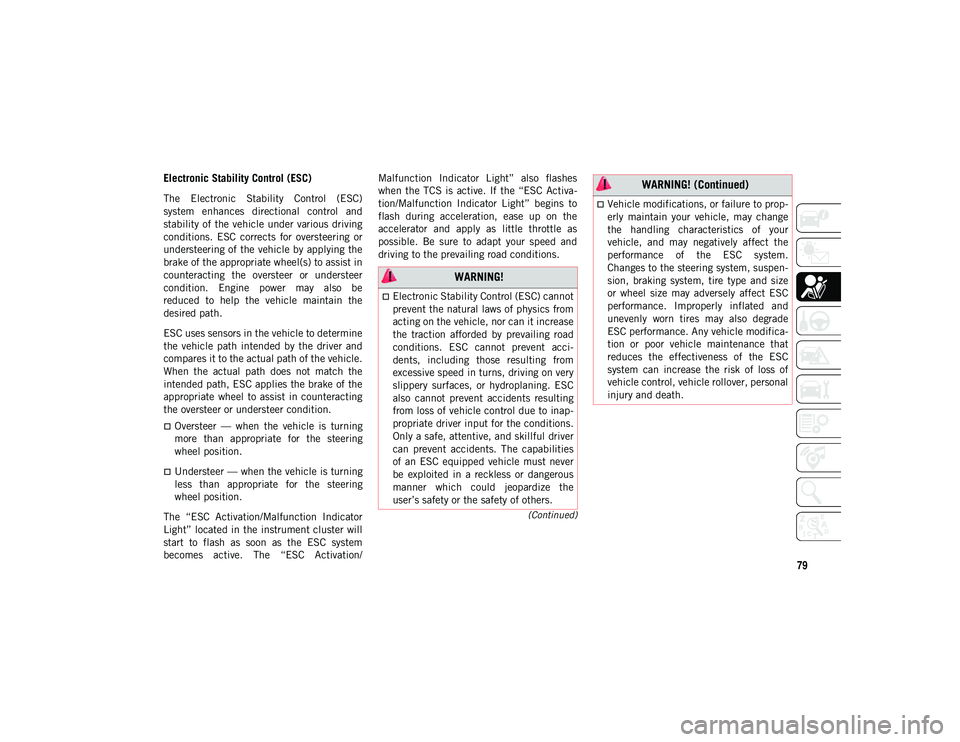
79
(Continued)
Electronic Stability Control (ESC)
The Electronic Stability Control (ESC)
system enhances directional control and
stability of the vehicle under various driving
conditions. ESC corrects for oversteering or
understeering of the vehicle by applying the
brake of the appropriate wheel(s) to assist in
counteracting the oversteer or understeer
condition. Engine power may also be
reduced to help the vehicle maintain the
desired path.
ESC uses sensors in the vehicle to determine
the vehicle path intended by the driver and
compares it to the actual path of the vehicle.
When the actual path does not match the
intended path, ESC applies the brake of the
appropriate wheel to assist in counteracting
the oversteer or understeer condition.
Oversteer — when the vehicle is turning
more than appropriate for the steering
wheel position.
Understeer — when the vehicle is turning
less than appropriate for the steering
wheel position.
The “ESC Activation/Malfunction Indicator
Light” located in the instrument cluster will
start to flash as soon as the ESC system
becomes active. The “ESC Activation/ Malfunction Indicator Light” also flashes
when the TCS is active. If the “ESC Activa
-
tion/Malfunction Indicator Light” begins to
flash during acceleration, ease up on the
accelerator and apply as little throttle as
possible. Be sure to adapt your speed and
driving to the prevailing road conditions.
WARNING!
Electronic Stability Control (ESC) cannot
prevent the natural laws of physics from
acting on the vehicle, nor can it increase
the traction afforded by prevailing road
conditions. ESC cannot prevent acci -
dents, including those resulting from
excessive speed in turns, driving on very
slippery surfaces, or hydroplaning. ESC
also cannot prevent accidents resulting
from loss of vehicle control due to inap -
propriate driver input for the conditions.
Only a safe, attentive, and skillful driver
can prevent accidents. The capabilities
of an ESC equipped vehicle must never
be exploited in a reckless or dangerous
manner which could jeopardize the
user’s safety or the safety of others.
Vehicle modifications, or failure to prop -
erly maintain your vehicle, may change
the handling characteristics of your
vehicle, and may negatively affect the
performance of the ESC system.
Changes to the steering system, suspen -
sion, braking system, tire type and size
or wheel size may adversely affect ESC
performance. Improperly inflated and
unevenly worn tires may also degrade
ESC performance. Any vehicle modifica-
tion or poor vehicle maintenance that
reduces the effectiveness of the ESC
system can increase the risk of loss of
vehicle control, vehicle rollover, personal
injury and death.
WARNING! (Continued)
2020_JEEP_CHEROKEE_UG_RHD_UK.book Page 79
Page 84 of 332
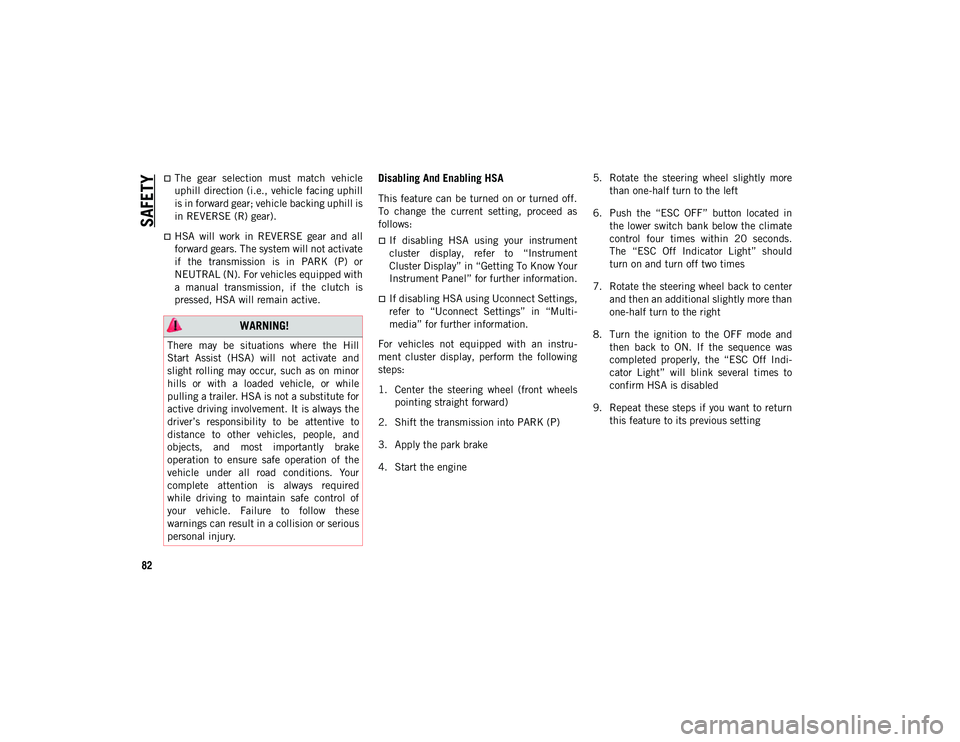
SAFETY
82
The gear selection must match vehicle
uphill direction (i.e., vehicle facing uphill
is in forward gear; vehicle backing uphill is
in REVERSE (R) gear).
HSA will work in REVERSE gear and all
forward gears. The system will not activate
if the transmission is in PARK (P) or
NEUTRAL (N). For vehicles equipped with
a manual transmission, if the clutch is
pressed, HSA will remain active.
Disabling And Enabling HSA
This feature can be turned on or turned off.
To change the current setting, proceed as
follows:
If disabling HSA using your instrument
cluster display, refer to “Instrument
Cluster Display” in “Getting To Know Your
Instrument Panel” for further information.
If disabling HSA using Uconnect Settings,
refer to “Uconnect Settings” in “Multi-
media” for further information.
For vehicles not equipped with an instru -
ment cluster display, perform the following
steps:
1. Center the steering wheel (front wheels pointing straight forward)
2. Shift the transmission into PARK (P)
3. Apply the park brake
4. Start the engine 5. Rotate the steering wheel slightly more
than one-half turn to the left
6. Push the “ESC OFF” button located in the lower switch bank below the climate
control four times within 20 seconds.
The “ESC Off Indicator Light” should
turn on and turn off two times
7. Rotate the steering wheel back to center and then an additional slightly more than
one-half turn to the right
8. Turn the ignition to the OFF mode and then back to ON. If the sequence was
completed properly, the “ESC Off Indi -
cator Light” will blink several times to
confirm HSA is disabled
9. Repeat these steps if you want to return this feature to its previous setting
WARNING!
There may be situations where the Hill
Start Assist (HSA) will not activate and
slight rolling may occur, such as on minor
hills or with a loaded vehicle, or while
pulling a trailer. HSA is not a substitute for
active driving involvement. It is always the
driver’s responsibility to be attentive to
distance to other vehicles, people, and
objects, and most importantly brake
operation to ensure safe operation of the
vehicle under all road conditions. Your
complete attention is always required
while driving to maintain safe control of
your vehicle. Failure to follow these
warnings can result in a collision or serious
personal injury.
2020_JEEP_CHEROKEE_UG_RHD_UK.book Page 82
Page 97 of 332
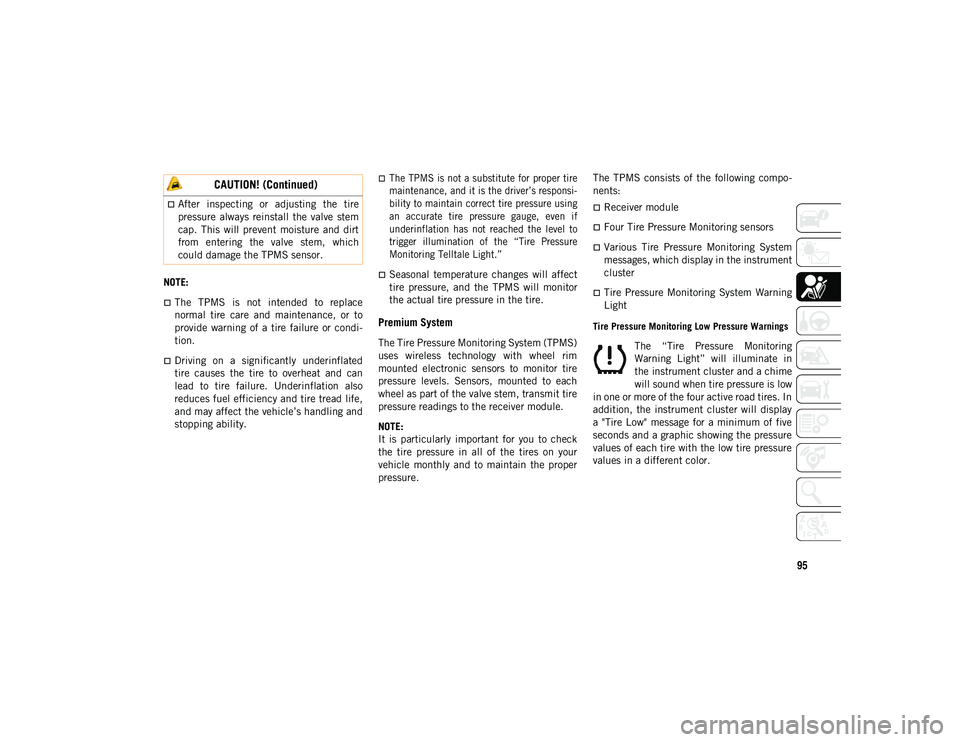
95
NOTE:
The TPMS is not intended to replace
normal tire care and maintenance, or to
provide warning of a tire failure or condi-
tion.
Driving on a significantly underinflated
tire causes the tire to overheat and can
lead to tire failure. Underinflation also
reduces fuel efficiency and tire tread life,
and may affect the vehicle’s handling and
stopping ability.
The TPMS is not a substitute for proper tire
maintenance, and it is the driver’s responsi -
bility to maintain correct tire pressure using
an accurate tire pressure gauge, even if
underinflation has not reached the level to
trigger illumination of the “Tire Pressure
Monitoring Telltale Light.”
Seasonal temperature changes will affect
tire pressure, and the TPMS will monitor
the actual tire pressure in the tire.
Premium System
The Tire Pressure Monitoring System (TPMS)
uses wireless technology with wheel rim
mounted electronic sensors to monitor tire
pressure levels. Sensors, mounted to each
wheel as part of the valve stem, transmit tire
pressure readings to the receiver module.
NOTE:
It is particularly important for you to check
the tire pressure in all of the tires on your
vehicle monthly and to maintain the proper
pressure. The TPMS consists of the following compo
-
nents:
Receiver module
Four Tire Pressure Monitoring sensors
Various Tire Pressure Monitoring System
messages, which display in the instrument
cluster
Tire Pressure Monitoring System Warning
Light
Tire Pressure Monitoring Low Pressure Warnings
The “Tire Pressure Monitoring
Warning Light” will illuminate in
the instrument cluster and a chime
will sound when tire pressure is low
in one or more of the four active road tires. In
addition, the instrument cluster will display
a "Tire Low" message for a minimum of five
seconds and a graphic showing the pressure
values of each tire with the low tire pressure
values in a different color.
After inspecting or adjusting the tire
pressure always reinstall the valve stem
cap. This will prevent moisture and dirt
from entering the valve stem, which
could damage the TPMS sensor.
CAUTION! (Continued)
2020_JEEP_CHEROKEE_UG_RHD_UK.book Page 95
Page 118 of 332
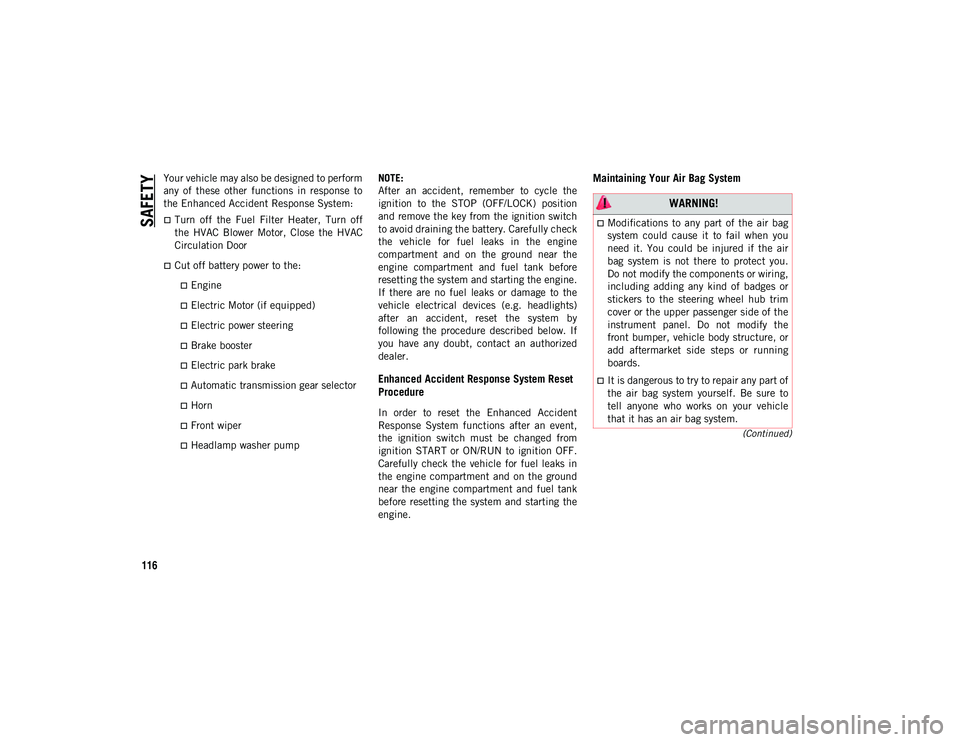
SAFETY
116
(Continued)
Your vehicle may also be designed to perform
any of these other functions in response to
the Enhanced Accident Response System:
Turn off the Fuel Filter Heater, Turn off
the HVAC Blower Motor, Close the HVAC
Circulation Door
Cut off battery power to the:
Engine
Electric Motor (if equipped)
Electric power steering
Brake booster
Electric park brake
Automatic transmission gear selector
Horn
Front wiper
Headlamp washer pumpNOTE:
After an accident, remember to cycle the
ignition to the STOP (OFF/LOCK) position
and remove the key from the ignition switch
to avoid draining the battery. Carefully check
the vehicle for fuel leaks in the engine
compartment and on the ground near the
engine compartment and fuel tank before
resetting the system and starting the engine.
If there are no fuel leaks or damage to the
vehicle electrical devices (e.g. headlights)
after an accident, reset the system by
following the procedure described below. If
you have any doubt, contact an authorized
dealer.
Enhanced Accident Response System Reset
Procedure
In order to reset the Enhanced Accident
Response System functions after an event,
the ignition switch must be changed from
ignition START or ON/RUN to ignition OFF.
Carefully check the vehicle for fuel leaks in
the engine compartment and on the ground
near the engine compartment and fuel tank
before resetting the system and starting the
engine.
Maintaining Your Air Bag System
WARNING!
Modifications to any part of the air bag
system could cause it to fail when you
need it. You could be injured if the air
bag system is not there to protect you.
Do not modify the components or wiring,
including adding any kind of badges or
stickers to the steering wheel hub trim
cover or the upper passenger side of the
instrument panel. Do not modify the
front bumper, vehicle body structure, or
add aftermarket side steps or running
boards.
It is dangerous to try to repair any part of
the air bag system yourself. Be sure to
tell anyone who works on your vehicle
that it has an air bag system.
2020_JEEP_CHEROKEE_UG_RHD_UK.book Page 116
Page 171 of 332
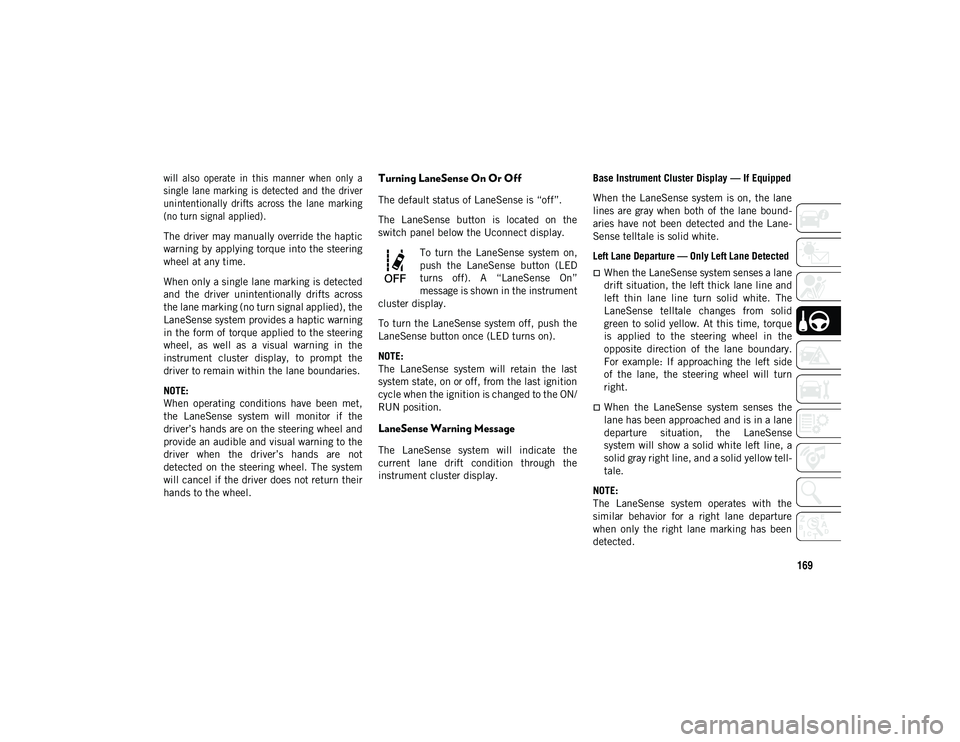
169
will also operate in this manner when only a
single lane marking is detected and the driver
unintentionally drifts across the lane marking
(no turn signal applied).
The driver may manually override the haptic
warning by applying torque into the steering
wheel at any time.
When only a single lane marking is detected
and the driver unintentionally drifts across
the lane marking (no turn signal applied), the
LaneSense system provides a haptic warning
in the form of torque applied to the steering
wheel, as well as a visual warning in the
instrument cluster display, to prompt the
driver to remain within the lane boundaries.
NOTE:
When operating conditions have been met,
the LaneSense system will monitor if the
driver’s hands are on the steering wheel and
provide an audible and visual warning to the
driver when the driver’s hands are not
detected on the steering wheel. The system
will cancel if the driver does not return their
hands to the wheel.Turning LaneSense On Or Off
The default status of LaneSense is “off”.
The LaneSense button is located on the
switch panel below the Uconnect display.To turn the LaneSense system on,
push the LaneSense button (LED
turns off). A “LaneSense On”
message is shown in the instrument
cluster display.
To turn the LaneSense system off, push the
LaneSense button once (LED turns on).
NOTE:
The LaneSense system will retain the last
system state, on or off, from the last ignition
cycle when the ignition is changed to the ON/
RUN position.
LaneSense Warning Message
The LaneSense system will indicate the
current lane drift condition through the
instrument cluster display. Base Instrument Cluster Display — If Equipped
When the LaneSense system is on, the lane
lines are gray when both of the lane bound
-
aries have not been detected and the Lane -
Sense telltale is solid white.
Left Lane Departure — Only Left Lane Detected
When the LaneSense system senses a lane
drift situation, the left thick lane line and
left thin lane line turn solid white. The
LaneSense telltale changes from solid
green to solid yellow. At this time, torque
is applied to the steering wheel in the
opposite direction of the lane boundary.
For example: If approaching the left side
of the lane, the steering wheel will turn
right.
When the LaneSense system senses the
lane has been approached and is in a lane
departure situation, the LaneSense
system will show a solid white left line, a
solid gray right line, and a solid yellow tell-
tale.
NOTE:
The LaneSense system operates with the
similar behavior for a right lane departure
when only the right lane marking has been
detected.
2020_JEEP_CHEROKEE_UG_RHD_UK.book Page 169